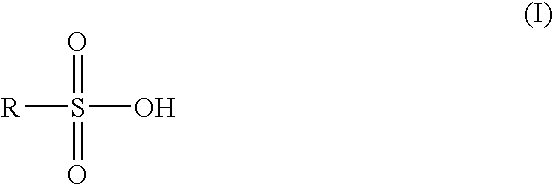pH buffered aqueous cleaning composition and method for removing photoresist residue
- Summary
- Abstract
- Description
- Claims
- Application Information
AI Technical Summary
Benefits of technology
Problems solved by technology
Method used
Image
Examples
Embodiment Construction
[0018] A composition and method comprising same for selectively removing residues from a substrate are disclosed herein. The composition disclosed herein is capable of selectively removing a residue, such as processing residue, from a substrate without attacking (to any undesired extent) structural materials of the substrate that might also be exposed to the composition.
[0019] As used herein, the term “residue” denotes an undesirable material present on the substrate. Residues that can be removed by the invention include but are not limited to: organic compounds, such as exposed and ashed photoresist material; ashed photoresist residue; UV- or X-ray-hardened photoresist; C-F-containing polymers; low and high molecular weight polymers and other organic etch residues; inorganic compounds such as metal oxides; ceramic particles from chemical mechanical planarization (CMP) slurries and other inorganic etch residues; metal containing compounds such as organometallic residues and metal o...
PUM
| Property | Measurement | Unit |
|---|---|---|
| Temperature | aaaaa | aaaaa |
| Temperature | aaaaa | aaaaa |
| Temperature | aaaaa | aaaaa |
Abstract
Description
Claims
Application Information
 Login to View More
Login to View More - R&D
- Intellectual Property
- Life Sciences
- Materials
- Tech Scout
- Unparalleled Data Quality
- Higher Quality Content
- 60% Fewer Hallucinations
Browse by: Latest US Patents, China's latest patents, Technical Efficacy Thesaurus, Application Domain, Technology Topic, Popular Technical Reports.
© 2025 PatSnap. All rights reserved.Legal|Privacy policy|Modern Slavery Act Transparency Statement|Sitemap|About US| Contact US: help@patsnap.com


